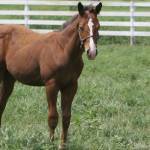Common Methods of Weaning Horses

The best weaning method is the one that fits your management system and results in a stress-free, relaxed, and uninjured mare and foal.
One popular method is pasture weaning (sometimes referred to as interval weaning) and is commonly used on farms where mares and foals are pastured in groups. At weaning time, one or two of the mares with the oldest foals are removed from the group, leaving their foals with the group. The mares should be removed quickly, ideally when the foals are occupied somewhere else, and housed in an area completely out of sight and hearing distance to the herd. Additional mares may be removed from the group after several days, or when foals reach the desired age. This process occurs until all mares have been removed. Some farms will introduce a nanny mare or gelding that remains with the weaned foals to provide some education. This method has proven to have little stress on the foals as most will quickly adjust to the herd of familiar horses. However, all foals should be observed in the hours following weaning to ensure they don’t become too distressed when they realize they can’t find their dams.
If pasture or interval weaning isn’t possible, which is often the case if there is only one foal to be weaned, other common methods are used. One method involves immediate separation from the dam, while the other is gradual separation. Immediate separation involves bringing the mare and foal into a box or yard and removing the mare. Some people will place the newly weaned foal with a companion animal or another just-weaned foal. Although a companion may seem a kinder option than leaving the foal alone, foals that are weaned and given companions have been shown to have increased stress response than those weaned and left alone. If you do plan to use a companion animal, it is important that the foal doesn’t become overly attached. This can make separation from that companion nearly as stressful as weaning from its mother. It is recommended that keeping foals alone for 24 hours after weaning and introducing company the next day is a better option. It is thought that weaning is complete after about one week of separation.
Gradual weaning is a common method. Allowing foals to see, hear, smell, and touch their dams through a fence, but not nurse, for seven days prior to complete separation is known to be less stressful in the days following weaning than abrupt weaning. Studies have shown a reduced stress response (lower plasma cortisol) and higher feed intake in the first week after weaning in gradually weaned foals. Foals weaned by this method also exhibit less emotional stress, vocalization, and activity than abruptly weaned foals. When comparing gradual weaning with abrupt weaning, there is little difference in feed intake from about two weeks after weaning, but the major benefit of gradual weaning is the reduced stress and reduced risk of injury.








